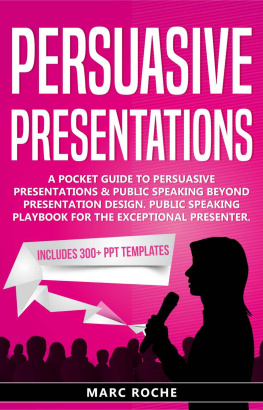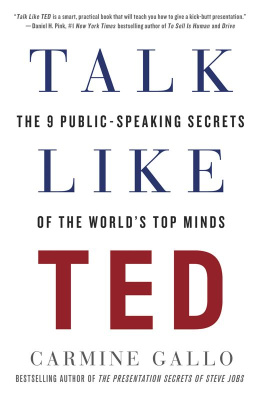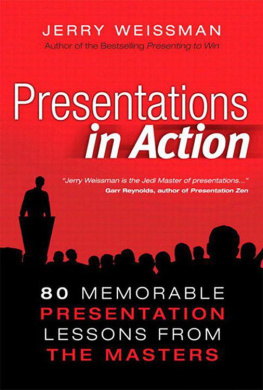Table of Contents
Chapter 1
What Is Presentation?
In This Chapter
- Communicating with presentations
- How this book is organized
- Storytelling, slides, and delivery
- The three principles
In late 2003, I was working for a consulting company as an analyst. The firm specialized in policy advising. Our clients were Russian ministries, senators, regulators, and formerly state-run, now privatized, companies. My job was to write reports to support decision-making processes. I had almost no contact with the clients, and frankly, I didnt suffer much because of that. I was quite happy just writing. But then came the day. One of the firms partners (to whom I am now very grateful) decided that it was time for me to see the big world. I had to present one of my recent reports before the firms client.
NOTE I tried to transform my report into a presentation in a PowerPoint deck. It was a bullet-point, teleprompter-style nightmare, which is becoming rare nowadays. I remember my boss telling me to use more pictures. In 2004, pictures came mostly from a clip-art gallery, which came by default with Microsoft Office. Also, I had zero design skills and my taste wasnt exactly ideal. So, yes, there were a few pictures, but frankly, it would have been much better without them.
I spoke for about 30 minutes and it all went very well, or at least I thought so. Unfortunately, it turned out that the client didnt quite share my view. He didnt understand why the report was prepared, what the findings were, and why we wasted so much time and money. My bosses had to improvise another presentation on the spot, one which, happily, did the job. The client calmed down but asked that they never delegate any presentations to me again. I was so frustrated that I promised myself to master the skill in the next few months.
This is how it all started. Two years later, the client (albeit a different one) asked for me to present whenever possible. Four years later, Id read Jim Collinss book Good to Great and decided to do for a living what I found I could do bestgive presentations. Next year, I published a presentation called Death by PowerPoint, which to my utter surprise went viral, having been viewed by more that one million people as of now. It was the greatest reassurance that the path that Ive chosen is the right one. Im currently teaching presentations at one of Russias best business schools, doing corporate workshops, practicing as a consultant, and occasionally working with Mercator, Russias leading producer of corporate films, business presentations, and infographics.
What Are Presentations?
We live in a world in which nobody knows how to do anything. What I mean is that capitalism is based on the idea of division of labor and the labor is divided as never before. With division of labor as great as ever, we have to connect via words, symbols, and electronic code. We have to connect via phone conversations, written reports, e-mails and instant messaging, blogs, micro-blogs, and via just plain water cooler conversationsand presentations, yes, via presentations. We have to speak publicly more now than ever.
Presentations are an extremely complex and expensive form of human communication. The interaction is relatively short but the combined time of all the people involved costs a lot. The only explanationas to why people continue to give presentations despite their complexity and cost is that they are also sometimes tremendously impactful. Also, sometimes, theres a lot at stake. People give presentations before commencing expensive projects and after finishing them. It makes sense to conduct extensive preparations in these cases, and theres almost no limit on how deep and wide you can go. You can rehearse, you can rearrange your slides, and you can research for new arguments in support of your point. So, whenever I am asked to help with a presentation, my first question is inevitably, What is the presentation in this case? Answers differ vastly.
Moreover, with more presentations being e-mailed rather than presented, this part is quickly becoming less important.
People frequently think that presentations are about delivery, about acting skills, and about how you say what you have to say. In the end, these aspects are what we see and hear, but are only the tip of the iceberg . People also think that presentations are mostly about slides. This is what I am asked to do a lot: make slides. The word slides has become synonymous with the word presentations in some organizations. People spend lots of time designing the right slides, making them so they can work with or without the actual presenter.
Apart from slides, theres another part that has to do with structure and argumentation, which is whole different domain. It has to do with what you say rather than how you say it. This part requires storytelling, script- and speechwriting skills, and a deep knowledge of the content. Can any single person possibly become an expert in all these fields? Can you become a present-day Renaissance person: a scriptwriter, a graphics designer, and a master of verbal and nonverbal delivery?
The short answer is yes, but let me make a confession first. My education is in finance. As you are probably aware, finance is one of the most tedious professions on Earth. Its really not far from accounting. I spent three years working as a financial controller for Citibank. At some point, I even considered a career in one of the Big Four auditing firms. Before my involvement with presentations, I never seriously thought of myself as a creative type. I was never good at oral communications; my only serious strength was writing. I wasnt even a good storyteller, as my reports didnt require any storytelling skills (or so I thought at the time). As I mentioned, I never studied graphics design in any systematic manner. I wasnt a good actor. So, yes, it is possible to become good at something as complex as presentations. It is possible even without any existing skills and without dedicating your whole life to it. After all, I didnt quit my job to learn how to give presentations. The first thing you need is motivation. I studied because of my initial failure; you might study because of your initial success. The second thing you need is a plan. The purpose of this book is to give you the plan.
Three more points about this book:
is a slide from my presentations training workshop. Its what I show people when I want to explain what presentations are. Coincidently, this is also how this book is organized. It is split into three major parts. Part I is about story structure, Part II is about slides, and Part III is about delivery. Also, I have three broad principles that I use in my work. In each part there are three chapters and each chapter will follow one broad topic, thus producing a nice three-by-three matrix. In this chapter, I give you a brief introduction to the three parts and three principles.
How this book is organized.

This book comes with illustrations, and I designed almost all of them by myself with no external help. I briefly considered hiring a professional graphics designer but realized that it would not be fair. If I say that everybody can learn to design slides by applying some principles and practicing, I should at least be able to do it myself. So I did. I am not a professional designer but at least they are authentic (which I believe is exceptionally important).
This book mostly relies on my five years of deliberate practice in the art of presentations. This is not a scientific book. I love science, and I care a great deal about empirical evidence. Unfortunately, however, some of the topics I discuss here are grossly under-researched. Sometimes, I have no other choice but to jump to conclusions, which just seem logical to me and are based on nothing but experience.











